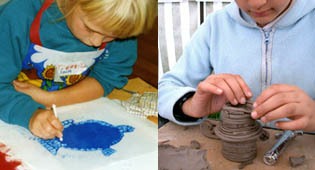











facing the future
New ways of thinking
The structure of the web is designed to allow links to be established in a very flexible way between bits of information (web sites, images, words, books, reports, news etc. etc.) -
When we search for something, anything containing that word has the potential to be ‘found'. It is a computational process, not one which is controlled by editors as in traditional print media, or organised by librarians in a book filing system.
For instance ‘yellow' might lead not just to shades of yellow, but to a wide variety of results -
In the past if you wanted a picture of a leopards spots or butterfly wings you might be lucky and have one or two images in an encyclopaedia, or some in your children books. If not you would have to go to a library or a bookshop to find an image.
Now you can access thousands on the internet -
We also talk about items that have gone 'viral' -
Training to think and see differently
This new kind of ‘associative thinking’ has long been a method used by creative people as a means of generating ideas and problem solving. Making use of serendipity (accidental discoveries or thoughts), thinking ‘outside the box’, or ‘lateral thinking’ as Edward de Bono termed it in the 1960’s.
who is this? > Edward de Bono
Art and design students learn how to look as part of the creative process -
These are methods for thinking used by many different professions where ideas play and important role -
Steven Johnson, in his book ‘Where Good Ideas Come From’ (publ. 2010) writes in great depth about the nature and value of serendipity. The power of random, accidental connections in the development of ideas:
“Serendipity is built out of happy accidents, to be sure, but what makes them happy is the fact that the discovery you have made is meaningful to you. It completes the hunch [idea], or opens up a door…
Serendipity discoveries often involve exchanges across traditional disciplines. If you visit the serendipity page of wikipedia you are one click away from entries on LSD, Teflon, Parkinson’s disease, Sri Lanka, Isaac Newton, Viagra and about two hundred other topics of comparable data…
No medium in history has ever offered such likely trails of connection and chance in such an intuitive and accessible form.”
resource link > Steven Johnson: Where Good Ideas Come From
Instant access via the internet combined with associative thinking and serendipity is the fundamental difference between a few thousand privileged people accessing information and freely interacting, to millions of people doing so.
what do we mean -
• there is special knowledge and understanding to be gained by making things
• childhood plays a vital part in this innovative process
a historical perspective
• observation, trial and error
• origins of maths
• patterns and geometry
facing the future
growing concerns
• Neil MacGregor
• Sherry Turkle
• Seymour Papert